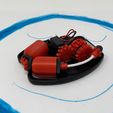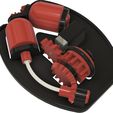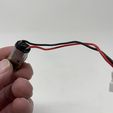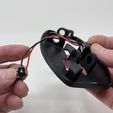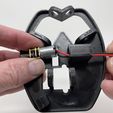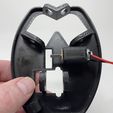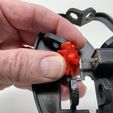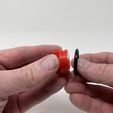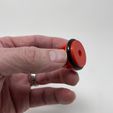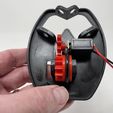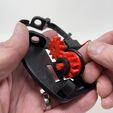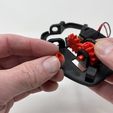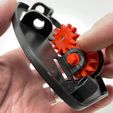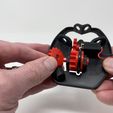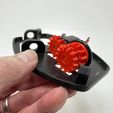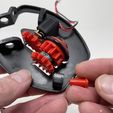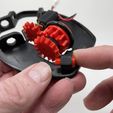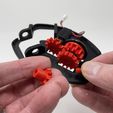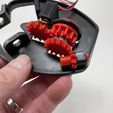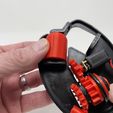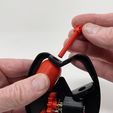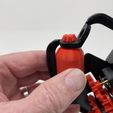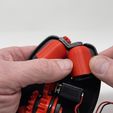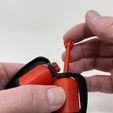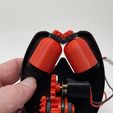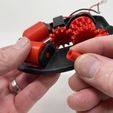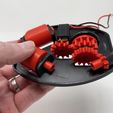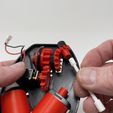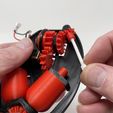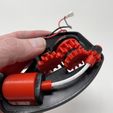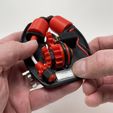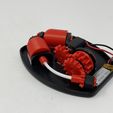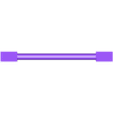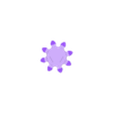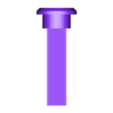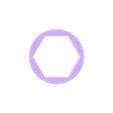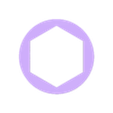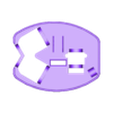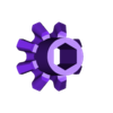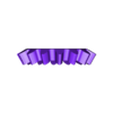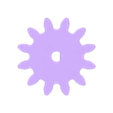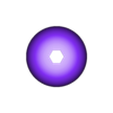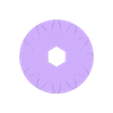Parts.
To assemble this model, I acquired the following parts:
• One 3.7vdc 100ma Lithium Battery (https://www.adafruit.com/product/1570).
• One JST PH 2-Pin Cable (https://www.adafruit.com/product/3814).
• One N20 6VDC 100RPM to 120RPM gear motor.
• One O-Ring, R-18 (22mm ID, 3.5mm section).
And I designed and 3D printed the following parts using PLA (unless otherwise noted) at .15mm layer height, 20% infill:
• One "Axle, Flex.stl", 3D printed using TPU filament on a TPU raft with TPU support.
• One "Axle, Gear, Bevel (1.8m, 8t), Axle, Flex.stl".
• Two "Axle, Wheel, Font.stl".
• One "Axle, Wheel, Rear.stl".
• One "Bushing, Axle, Font, Flex.stl".
• One "Bushing, Axle, Front.stl".
• One "Bushing, Axle, Wheel, Rear.stl".
• One "Chassis.stl".
• One "Gear, Bevel (1.8m, 8t), Axle, Flex.stl".
• One "Gear, Bevel (1.8m, 14t).stl".
• One "Gear, Motor (1.8m, 12t).stl".
• Two "Wheel, Font.stl".
• One "Wheel, Rear.stl".
This is a high precision print and assembly model using at times very small parts and in very tight spaces. Prior to assembly, test fit and trim, file, sand, etc. all parts as necessary for smooth movement of moving surfaces, and tight fit for non moving surfaces. Depending on you printer, your printer settings and the colors you chose, more or less trimming, filing and/or sanding may be required. Carefully file all edges that contacted the build plate to make absolutely certain that all build plate "ooze" is removed and that all edges are smooth. I used small jewelers files and plenty of patience to perform this step.
Motor Preparation and Installation.
To prepare the motor and install it, I performed the following steps:
• Soldered JST connector wires to the motor so that when power is applied, the motor rotates clockwise as viewed from the axle end.
• Pressed the motor assembly into "Chassis.stl".
Gear Train Assembly.
To assemble the gear train, I performed the following steps:
• Positioned "Gear, Motor.stl" in the chassis assembly, then slid the motor into the hole in the gear, and finally centered the gear in the chassis slot.
• Slid the O-Ring onto "Wheel, Rear.stl".
• Positioned the rear wheel in the chassis assembly.
• Secured the rear wheel to the chassis using "Axle, Wheel, Rear.stl".
• Pressed "Bushing, Axle, Wheel, Rear.stl" onto the rear wheel axle, making certain the rear wheel rotated freely.
• Pressed "Gear, Bevel (1.8m, 14t).stl" onto the rear wheel axle (a small dot of glue may assist in retaining the gear on the axle).
• Placed "Axle, Gear, Bevel (1.8m, 8t), Axle, Flex.stl" into the chassis assembly.
• Pressed "Gear, Bevel (1.8m, 8t), Axle, Flex.stl" onto the axle (a small dot of glue may assist in retaining the gear on the axle) making certain the gear rotated freely.
Front Wheel Assembly.
To assemble the front wheels, I performed the following steps:
• Positioned one "Wheel, Front.stl" into the chassis assembly.
• Secured the front wheel in the chassis using one "Axle, Wheel, Front.stl".
• Positioned the remaining "Wheel, Front.stl" into the chassis assembly.
• Secured the remaining front wheel in the chassis using the remaining "Axle, Wheel, Front.stl". This is a very complicated step. I pinched the two front wheels together with one hand, made certain the gear teeth were aligned, then used plenty of pressure to engage the gears.
• Pressed "Bushing, Axle, Front.stl" onto the right front axle shaft (a small dot of glue may assist in retaining the bushing on the axle).
Final Assembly and Track Preparation.
For final assembly, I performed the following steps:
• Pressed "Bushing, Axle, Front, Flex.stl" onto the left front wheel axle (a small dot of glue may assist in retaining the bushing on the axle).
• Pressed one end of "Axle, Flex.stl" into the small bevel gear.
• Pressed the remaining end of the flex axle into the left wheel flex bushing.
• Placed double sided sticky tape onto the battery.
• Pressed the battery into the chassis assembly.
With the model assembled, I used a wax crayon to draw a circle on a piece of smooth paper (as seen in the video, my circle is perhaps a little too small but I made it that size to fit in my photo booth). The crayon circle is about one inch wide, and is applied to the paper very thick. Once my circular track was completed, I placed it on a smooth, flat, level surface, powered up the model, placed the front wheels astride the crayon circle, and let it go! If the model veers off the track at a particular point, simply add more crayon.
And that is how I 3D printed and assembled "Crayon Car Mechanism".
I hope you enjoyed it!

/https://fbi.cults3d.com/uploaders/13550170/illustration-file/fc2d24ff-100b-4c5c-9ac7-feb19e6b66d1/Image00a.jpg)

